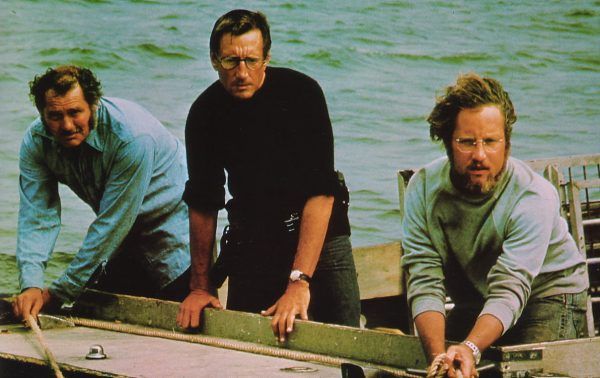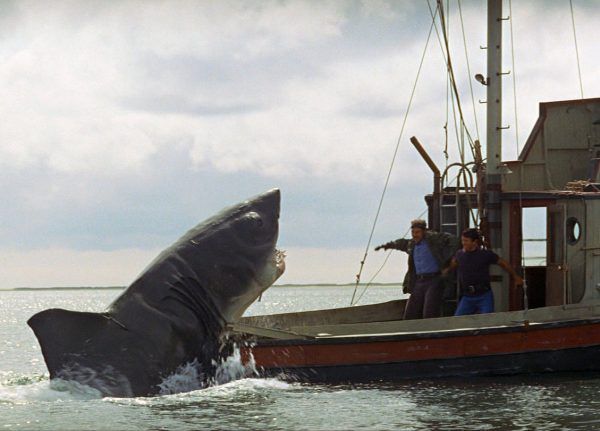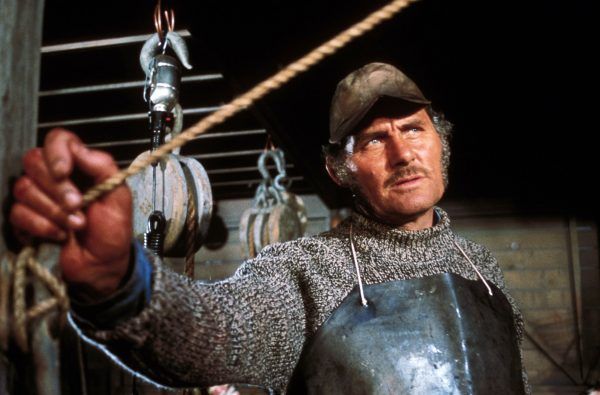In celebration of its 45th anniversary this month, Universal has released a spiffy 4K Ultra HD special edition of Jaws and foolishly sent me a copy for free, even though I would’ve paid upwards of $5,000 for it. Equally foolishly, my editors are paying me to write this feature about Jaws, a task I would’ve done for free and/or an excuse to watch Jaws during work hours.
For those of you somehow not familiar, Jaws is director Steven Spielberg’s 1975 breakout hit about a bunch of wealthy white people who refuse to obey government orders to avoid the beach. It also involves a shark so large it can only be the end point of an ancient prophecy. The shark eats a bunch of people, the chief of police teams up with a cocky marine biologist and the most grizzled drunk in the entire fishing industry to hunt the shark down, and after spending several nights getting toasted on bathtub gin they heroically sink their boat and somehow manage to kill the shark in the process. Oh, and the fisherman gets eaten. It is, without hyperbole, the greatest motion picture ever made.
I’ve easily seen Jaws over 100 times. I got my first VHS copy of it when I was but a wee lad of around 4, and proceeded to wear the tape out. Over the course of my life, I’ve owned 6 different copies of it. I’ve so thoroughly memorized the film that I could tell immediately that the original audio track had been changed on the 2000 DVD version to “update” some of the sound effects, and I was furious. (Don’t worry, the original audio has since been restored in its subsequent DVD and Blu-ray releases.) For some reason, I keep going back to Jaws, and I’m definitely not the only one – it remains a hugely popular movie that constantly shows up on “best of all time” lists. Exciting new filmmakers like Jordan Peele have cited it as an influence. It’s an absolute classic, and I’m going spend the next few hundred words trying to put my finger on exactly why that is.
Part of the longevity of Jaws can be attributed to the fact that it feels like a modern film – movies of the 1970s were, generally speaking, very different from movies in the 21st century. They were generally slower-paced overall, but the primary difference is in the camera work. Quick zooms, uncomfortably invasive close-ups, and static establishing shots were some of the standard tricks of the day. Spielberg eschews all that in Jaws, and cobbles together bits from other greats like Hitchcock and Kurosawa (with some of his own style to boot) to create a visual language that winds up becoming the “look” of blockbuster films. Nowadays, if you want a movie to feel like a summer blockbuster, you make it look like a Spielberg film. And Jaws was the genesis point of that. Also, the movie moves – it’s a fast-paced 2 hours almost to the minute, with the tension lasting until almost the very last scene.
Much ado was made about the primary visual effect of Jaws, which is the mechanical rubber shark puppet. And while it’s undeniably true that the mechanical shark was a pain in the ass that rarely worked and contributed to the film’s much-publicized production delays (filming alone wound up lasting for 159 days), the effects actually look pretty good, even in 2020. Part of the reason the effects hold up is unquestionably due to the fact that they are sparingly used. We almost never see the shark; in fact, it doesn’t even appear onscreen until the 1-hour mark. But the invisibility of the shark is one of the things that made Jaws so famous, and it’s the element of the film that is most often copied by other filmmakers. Out of pure necessity, Spielberg uses POV shots and the shark’s theme to establish its presence. If you notice, we only ever hear the iconic theme when the shark is actually present – during the hoax scene, in which two kids scare everyone at the beach with a cardboard fin, the shark’s theme is not heard. It’s a very subtle technique that you might not consciously notice even after repeated viewings, but you always feel it. That music means it’s shark time, and somebody’s getting ate. Later on in the film, a series of floating yellow barrels are used to let us know when the shark is there. And when that big rubber bastard finally does burst out of the water, it looks… totally fine! It’s fine. It’s not any less believable than that gigantic mechanical brachiosaur head that shits boogers on Lex in Jurassic Park, because the movie treats it as a completely real and terrifying threat. When Quint (Robert Shaw) gets eaten, you can literally see the shark’s rubber teeth bending flat against his torso. But it hardly matters, because Shaw is selling his character’s demise so disturbingly, and the scene is bloody and shocking.
Another factor in the timelessness of Jaws is, appropriately, that it doesn’t date itself. That’s a weird thing to say about a movie that celebrates its 45th anniversary this year, but apart from the fashion in the film, there’s nothing that really places it in any specific time. Sure, there are no cellphones, but cellphones wouldn’t really help all that much in any particular scene. And the central action of the film – going fishing for a shark – is a fairly low-tech operation, all things considered. You’re not really wondering why nobody is checking Twitter for updates on the shark, or why Hooper (Richard Dreyfuss) doesn’t post a quick Tik Tok before diving in to inspect Ben Gardner’s boat. The movie is tightly focused on a small group of characters, none of whom ever stop to drop in their thoughts about Nixon’s resignation or the 1973 oil crisis. Pretty much the only major difference in the plot if this movie were made in 2020 would be people arguing via Facebook memes over whether or not the shark was a liberal hoax.
Quint’s Indianapolis speech is the only plot point that actually locks Jaws down to a specific time period; if we imagine that the events of the film take place today, we also have to imagine that Quint is around 100 years old for him to have been onboard the doomed ship. But it actually doesn’t have much of an effect in that regard, at least not in my opinion, because Quint’s connection to the Indianapolis is primarily thematic. He was on board a ship that sunk, and her surviving crew were assaulted by sharks for several days. While this grim piece of history provides Quint with his Ahab-like obsession to kill the shark, it doesn’t necessarily have to have been that specific event. It could’ve been any shipwreck, or indeed no shipwreck at all. We see how prideful Quint is throughout the entire film, as a salty old fart who has been killing sharks for years. The source of his obsession doesn’t need to be anything more than just his bewilderment over one of the fish he’s hunted for so long finally getting the best of him.
Finally, Jaws is just good, man. It created the idea of summer blockbusters, for better or worse. Before Jaws, studios would release their major movies just kind of whenever. There wasn’t this culture of saving your big movies for the summer months (and honestly, it doesn’t make much sense when you think about it – people aren’t more or less likely to go to the movies in February then they are in July). Jaws, a breezy popcorn thriller that scared the shit out of everyone who went to the beach that summer (and every summer forever after) quickly became the highest-grossing movie of all time. Until Star Wars took the record a few years later, but still.
Jaws spawned a number of imitators throughout the 70s and 80s, including some that tried to change the killer animal, like Grizzly and Alligator, and others that were just straight-up copycat shark movies. But no imitator has ever reached the level of cultural immortality like Jaws. To paraphrase comedian Paul F. Tompkins on an episode of the podcast How Did This Get Made?, “How many good shark movies are there? Is it still just the one?”




